化学发展史(英文)
- 格式:doc
- 大小:26.00 KB
- 文档页数:3




标题 氨气和发现与合成关键词 氨 / 化学史1727 年英国的牧师、化学家哈尔斯( Hales,S.1677 , 1761),用氯化铵与石灰的混合物在以水封闭的曲颈瓶中加热,只见水被吸入瓶中而不见气体放出。
177,年化学家普利斯德里重作这个实验,采用汞代替水来密闭曲颈瓶,制得了碱空气(氨)。
他还研究了氨的性质,发现它易溶于水、可以燃烧,还发现在氨气中通以电火花时,其容积增加很多,而且分解为两种气体;一种是可燃的氢气;另一种是不能助燃的氮气。
从而证实了氨是氮和氢的化合物。
其后戴维等化学家继续研究,进一步证实了 2容积的氨通过火花放电之后,分解为 1 容积的 氮气和,容积的氢气。
19世纪以前,农业生产所需氮肥的来源,主要是有机物的副产物和动植物的废物,如粪 便、种子饼、腐鱼、屠宰废料、腐烂动植物等。
那时哨石的产量很有限,而且主动用于军工 业生产。
1809年,智利的沙漠地区发现了一个巨大的硝酸钠矿床,很快就开发利用。
到 1850年世界上硝盐的供应,主要是智利。
随着农业的发展和军工生产的需要,迫切要求建立规模巨大的探索性的研究。
他们设想,能不能把空气中大量的氮气固定下来。
于是开始设计以氮 和氢为原料的合成生产氨的流程。
尤其是在 18 , 7年,德国发生了农业危机,首都柏林爆发了抢夺粮食的“土豆革命”,引起了政府重视生产粮食,因而开展了对土壤的研究。
在土壤的肥料问题上,曾经流行一种腐殖质理论,认为作物是依赖土壤中的腐殖质为养料的。
而腐殖质这种东西只能来源于腐败的动植物体,因此肥料的来源是有限的。
当时德国的著名化学家李比希致力于研究植物所需要的碳和氢的来源问题。
为此,他对稻草和其它许多干草的分析中发现,植物中含碳的量不是因土壤的条件不同而有所不同,因此他支持植物中的碳来自大气的观点。
他在分析各种植物的汁液时,发现其中都含有氨,同时发现雨水中也有氨。
大气中的氮很不活泼,也不能直接被植物所吸收,而氨却容易被植物吸收,因此他判断植物是通过吸收氨来获得含氮养料的。
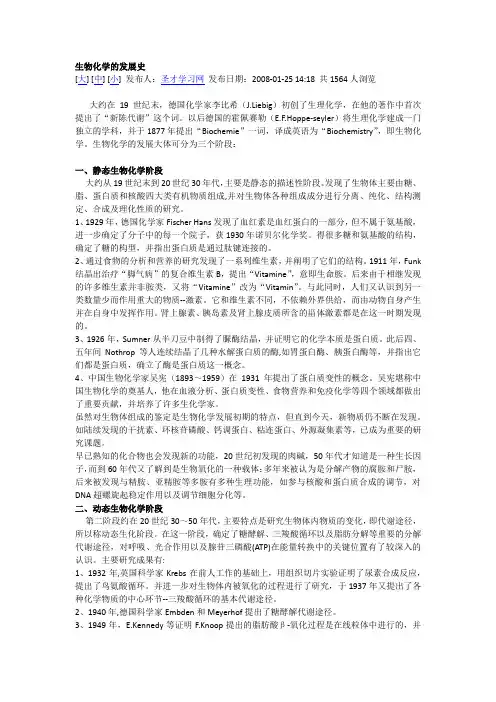
生物化学的发展史[大] [中] [小] 发布人:圣才学习网发布日期:2008-01-25 14:18 共1564人浏览大约在19世纪末,德国化学家李比希(J.Liebig)初创了生理化学,在他的著作中首次提出了“新陈代谢”这个词。
以后德国的霍佩赛勒(E.F.Hoppe-seyler)将生理化学建成一门独立的学科,并于1877年提出“Biochemie”一词,译成英语为“Biochemistry”,即生物化学。
生物化学的发展大体可分为三个阶段:一、静态生物化学阶段大约从19世纪末到20世纪30年代,主要是静态的描述性阶段。
发现了生物体主要由糖、脂、蛋白质和核酸四大类有机物质组成,并对生物体各种组成成分进行分离、纯化、结构测定、合成及理化性质的研究。
1、1929年,德国化学家Fischer Hans发现了血红素是血红蛋白的一部分,但不属于氨基酸,进一步确定了分子中的每一个院子,获1930年诺贝尔化学奖。
得很多糖和氨基酸的结构,确定了糖的构型,并指出蛋白质是通过肽键连接的。
2、通过食物的分析和营养的研究发现了一系列维生素,并阐明了它们的结构。
1911年,Funk 结晶出治疗“脚气病”的复合维生素B,提出“Vitamine”,意即生命胺。
后来由于相继发现的许多维生素并非胺类,又将“Vitamine”改为“Vitamin”。
与此同时,人们又认识到另一类数量少而作用重大的物质--激素。
它和维生素不同,不依赖外界供给,而由动物自身产生并在自身中发挥作用。
肾上腺素、胰岛素及肾上腺皮质所含的甾体激素都是在这一时期发现的。
3、1926年,Sumner从半刀豆中制得了脲酶结晶,并证明它的化学本质是蛋白质。
此后四、五年间Nothrop等人连续结晶了几种水解蛋白质的酶,如胃蛋白酶、胰蛋白酶等,并指出它们都是蛋白质,确立了酶是蛋白质这一概念。
4、中国生物化学家吴宪(1893~1959)在1931年提出了蛋白质变性的概念。
吴宪堪称中国生物化学的奠基人,他在血液分析、蛋白质变性、食物营养和免疫化学等四个领域都做出了重要贡献,并培养了许多生化学家。
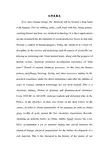
化学发展史Ever since human beings, the chemical will be formed a deep bond with humans. Fire by rubbing sticks, cook food with fire, firing pottery, smelting bronze and iron, are chemical technology. It is these applications, greatly promoted the development of social productive forces at that time become a symbol of human progress. Today, the chemical as a basis for discipline, in the science and technology and all aspects of social life, are playing an increasing role. From ancient times, along with the progress of human society, chemical, historical development experience of what times? Period of ancient chemical processes. At this time the human pottery, metallurgy, brewing, dyeing and other processes, mainly in the practical experience under the direct inspiration came after the number of years to explore, chemical knowledge has not been formed. This is a chemistry infancy. Period of alchemy and pharmaceutical chemistry. From 1500 BC to AD 1650, alchemy warlock and alchemist who, in the Palace, in the churches, in their own home, in the deep forests of the smoky, in order to obtain immortality of the panacea, in order to obtain glory wealth of gold, started the first chemistry experiment. Records, summing up alchemy books, in China, Arabia, Egypt, Greece has a lot. Have accumulated a lot of material during this period between the chemical change, chemical preparations for the further development of a rich material. This is the chemical in the history of the strains of ourbreathtaking scene. Later, alchemy, alchemy, rise and fall several times so that people can see it more absurd side. Chemical shift in medicine and metallurgy have been given the proper play. In Europe during the Renaissance, the publication of several books on chemistry, for the first time with the "chemical" term. English, chemistry originated in alchemy, the alchemy. chemist still has a two related meanings: chemists and pharmacists. These can be said that chemistry grew out of alchemy and the cultural heritage of the pharmaceutical industry. Phlogiston chemistry period. From 1650 to 1775, with the metallurgical industry and laboratory experience, the people have come up perceptual knowledge that the combustible material to burn because it contains phlogiston, the combustion process is combustible in the process of release of phlogiston, phlogiston released combustible later reduced to ashes. Quantitative chemical period, while the period of Modern Chemistry. Before and after 1775, Lavoisier quantitative chemical experiment described the oxidation theory of combustion, creating a period of quantitative chemistry. During this period the establishment of a number of basic laws of chemistry, made of atomic theory, periodic law of elements found in the development of the organic structure theory. All of this for the development of modern chemistry laid a solid foundation. Science and mutual penetration period, while the period of modern chemistry. The early twentieth century, the development of quantum theory to chemistryand physics have a common language to address many of the chemical on the outstanding issues; on the other hand, chemical Youxiang infiltration of such disciplines as biology and geology, so that proteins, enzymes structure has been gradually solved.人类自从,化学将形成与人类结下了不解之缘。

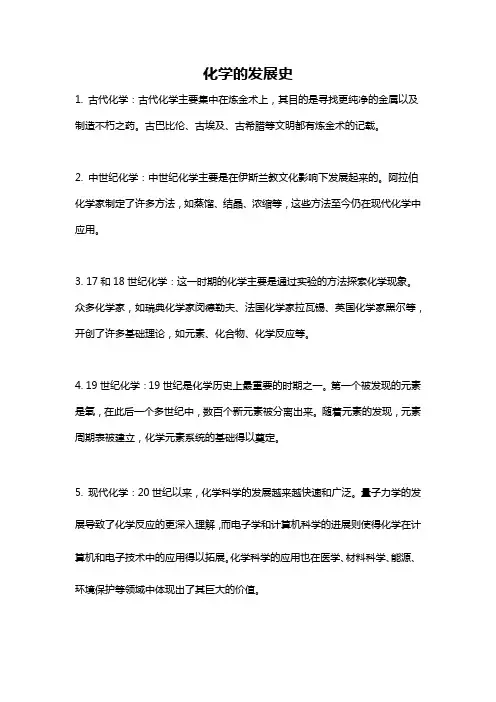
化学的发展史
1. 古代化学:古代化学主要集中在炼金术上,其目的是寻找更纯净的金属以及制造不朽之药。
古巴比伦、古埃及、古希腊等文明都有炼金术的记载。
2. 中世纪化学:中世纪化学主要是在伊斯兰教文化影响下发展起来的。
阿拉伯化学家制定了许多方法,如蒸馏、结晶、浓缩等,这些方法至今仍在现代化学中应用。
3. 17和18世纪化学:这一时期的化学主要是通过实验的方法探索化学现象。
众多化学家,如瑞典化学家闵德勒夫、法国化学家拉瓦锡、英国化学家黑尔等,开创了许多基础理论,如元素、化合物、化学反应等。
4. 19世纪化学:19世纪是化学历史上最重要的时期之一。
第一个被发现的元素是氧,在此后一个多世纪中,数百个新元素被分离出来。
随着元素的发现,元素周期表被建立,化学元素系统的基础得以奠定。
5. 现代化学:20世纪以来,化学科学的发展越来越快速和广泛。
量子力学的发展导致了化学反应的更深入理解,而电子学和计算机科学的进展则使得化学在计算机和电子技术中的应用得以拓展。
化学科学的应用也在医学、材料科学、能源、环境保护等领域中体现出了其巨大的价值。
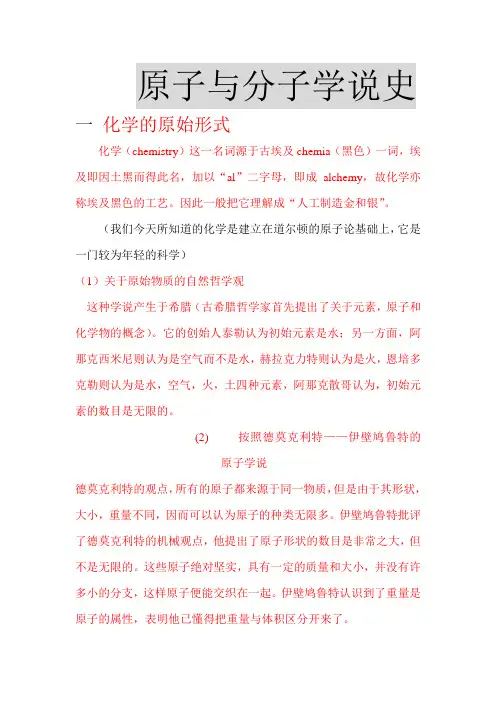
原子与分子学说史一化学的原始形式化学(chemistry)这一名词源于古埃及chemia(黑色)一词,埃及即因土黑而得此名,加以“al”二字母,即成alchemy,故化学亦称埃及黑色的工艺。
因此一般把它理解成“人工制造金和银”。
(我们今天所知道的化学是建立在道尔顿的原子论基础上,它是一门较为年轻的科学)(1)关于原始物质的自然哲学观这种学说产生于希腊(古希腊哲学家首先提出了关于元素,原子和化学物的概念)。
它的创始人泰勒认为初始元素是水;另一方面,阿那克西米尼则认为是空气而不是水,赫拉克力特则认为是火,恩培多克勒则认为是水,空气,火,土四种元素,阿那克散哥认为,初始元素的数目是无限的。
(2)按照德莫克利特——伊壁鸠鲁特的原子学说德莫克利特的观点,所有的原子都来源于同一物质,但是由于其形状,大小,重量不同,因而可以认为原子的种类无限多。
伊壁鸠鲁特批评了德莫克利特的机械观点,他提出了原子形状的数目是非常之大,但不是无限的。
这些原子绝对坚实,具有一定的质量和大小,并没有许多小的分支,这样原子便能交织在一起。
伊壁鸠鲁特认识到了重量是原子的属性,表明他已懂得把重量与体积区分开来了。
(原子概念沉寂了大概一千年的时间,原子概念的复活大约在16世纪,首先把原子学说应用到化学观方面的是德国哲学家森纳特)二原子——分子学说的创立与证实(一)波义耳——勒梅里的微粒学说早在17世纪时,微粒学说已经得到了发展,占据物理学和化学的许多不同领域。
这一时期的原子学说首先是从力学中借用来的,用逼真的,直观的图象来说明化学现象。
波义耳——勒梅里的微粒学说主要用来说明化学反应的机理和条件,在这些条件下不同的微粒能够相互作用。
他们从与宏观物质相类似的具体原子模型出发,创立了解释物质相互作用机理的学说。
(但他们都不能预见到未被研究过的物质微粒形状)。
(二)牛顿的原子论牛顿在著作中反对伊壁鸠鲁的原子论,他赋予原子具有驱动微粒相互作用的力量。
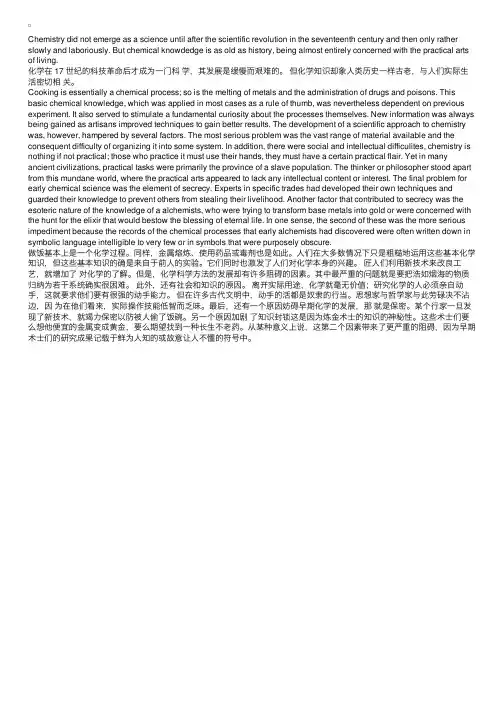
Chemistry did not emerge as a science until after the scientific revolution in the seventeenth century and then only rather slowly and laboriously. But chemical knowdedge is as old as history, being almost entirely concerned with the practical arts of living.化学在 17 世纪的科技⾰命后才成为⼀门科学,其发展是缓慢⽽艰难的。
但化学知识却象⼈类历史⼀样古⽼,与⼈们实际⽣活密切相关。
Cooking is essentially a chemical process; so is the melting of metals and the administration of drugs and poisons. This basic chemical knowledge, which was applied in most cases as a rule of thumb, was nevertheless dependent on previous experiment. It also served to stimulate a fundamental curiosity about the processes themselves. New information was always being gained as artisans improved techniques to gain better results. The development of a scientific approach to chemistry was, however, hampered by several factors. The most serious problem was the vast range of material available and the consequent difficulty of organizing it into some system. In addition, there were social and intellectual difficulites, chemistry is nothing if not practical; those who practice it must use their hands, they must have a certain practical flair. Yet in many ancient civilizations, practical tasks were primarily the province of a slave population. The thinker or philosopher stood apart from this mundane world, where the practical arts appeared to lack any intellectual content or interest. The final problem for early chemical science was the element of secrecy. Experts in specific trades had developed their own techniques and guarded their knowledge to prevent others from stealing their livelihood. Another factor that contributed to secrecy was the esoteric nature of the knowledge of a alchemists, who were trying to transform base metals into gold or were concerned with the hunt for the elixir that would bestow the blessing of eternal life. In one sense, the second of these was the more serious impediment because the records of the chemical processes that early alchemists had discovered were often written down in symbolic language intelligible to very few or in symbols that were purposely obscure.做饭基本上是⼀个化学过程。

化学发展史Ever since human beings, the chemical will be formed a deep bond with humans. Fire by rubbing sticks, cook food with fire, firing pottery, smelting bronze and iron, are chemical technology. It is these applications, greatly promoted the development of social productive forces at that time become a symbol of human progress. Today, the chemical as a basis for discipline, in the science and technology and all aspects of social life, are playing an increasing role. From ancient times, along with the progress of human society, chemical, historical development experience of what times? Period of ancient chemical processes. At this time the human pottery, metallurgy, brewing, dyeing and other processes, mainly in the practical experience under the direct inspiration came after the number of years to explore, chemical knowledge has not been formed. This is a chemistry infancy. Period of alchemy and pharmaceutical chemistry. From 1500 BC to AD 1650, alchemy warlock and alchemist who, in the Palace, in the churches, in their own home, in the deep forests of the smoky, in order to obtain immortality of the panacea, in order to obtain glory wealth of gold, started the first chemistry experiment. Records, summing up alchemy books, in China, Arabia, Egypt, Greece has a lot. Have accumulated a lot of material during this period between the chemical change, chemical preparations for the further development of a rich material. This is the chemical in the history of the strains of ourbreathtaking scene. Later, alchemy, alchemy, rise and fall several times so that people can see it more absurd side. Chemical shift in medicine and metallurgy have been given the proper play. In Europe during the Renaissance, the publication of several books on chemistry, for the first time with the "chemical" term. English, chemistry originated in alchemy, the alchemy. chemist still has a two related meanings: chemists and pharmacists. These can be said that chemistry grew out of alchemy and the cultural heritage of the pharmaceutical industry. Phlogiston chemistry period. From 1650 to 1775, with the metallurgical industry and laboratory experience, the people have come up perceptual knowledge that the combustible material to burn because it contains phlogiston, the combustion process is combustible in the process of release of phlogiston, phlogiston released combustible later reduced to ashes. Quantitative chemical period, while the period of Modern Chemistry. Before and after 1775, Lavoisier quantitative chemical experiment described the oxidation theory of combustion, creating a period of quantitative chemistry. During this period the establishment of a number of basic laws of chemistry, made of atomic theory, periodic law of elements found in the development of the organic structure theory. All of this for the development of modern chemistry laid a solid foundation. Science and mutual penetration period, while the period of modern chemistry. The early twentieth century, the development of quantum theory to chemistryand physics have a common language to address many of the chemical on the outstanding issues; on the other hand, chemical Youxiang infiltration of such disciplines as biology and geology, so that proteins, enzymes structure has been gradually solved.人类自从,化学将形成与人类结下了不解之缘。
化学历史的英文作文英文:Chemistry has a rich and fascinating history that spans thousands of years. From the ancient alchemists who sought to turn base metals into gold, to the modern scientists who are unlocking the secrets of the universe, chemistry has played a vital role in shaping our world.One of the earliest examples of chemistry can be found in ancient China, where alchemists were attempting to create an elixir of life that would grant immortality. They discovered many new substances and techniques, including gunpowder, which had a profound impact on warfare and technology.In the Middle Ages, alchemy spread to Europe, where it became associated with mysticism and the search for the philosopher's stone. Despite the many failures and false claims made by alchemists, their work laid the foundationfor modern chemistry.The scientific revolution of the 17th and 18th centuries marked a turning point in the history of chemistry. Scientists such as Robert Boyle and Antoine Lavoisier made groundbreaking discoveries about the nature of matter and the laws that govern chemical reactions. Their work paved the way for the development of modern chemistry as we know it today.In the 20th century, chemistry continued to advance at a rapid pace. Chemists such as Marie Curie and Linus Pauling made important discoveries about the structure of atoms and molecules, which led to the development of new materials and technologies.Today, chemistry plays a vital role in virtually every aspect of our lives, from the food we eat to the medicines we take. It is a constantly evolving field, as scientists continue to explore the mysteries of the universe and develop new materials and technologies that will shape our future.中文:化学有着丰富而迷人的历史,跨越了数千年。
《化学发展简史》学习心得英国近代实验科学的的始祖培根说过“学习历史可以使人明智。
”历史是记录人类文明发展的重要学科,人类在创新中前进,在错误中自我检讨,通过历史我们可以前人成功的经验和失败的教训,从而明智。
作为一名化学专业的学生,在大一的第一学期,我学习了《化学发展简史》这一门课程,该课生动的为我们讲述了古代化学、近代化学的发展历史以及其最新发展方向。
在学习这一门课程之前,我所学习的化学的化学知识仅停留在课本上,每一个元素,每个方程式,都像公式一样的记在脑子里,多少有些枯燥乏味。
然而在学习了这门课程后,我对化学的认识有了很大的变化,我了解到化学的发展与人类的生活紧紧相关,并且每一个新的发现背后都是一个小故事,化学这一学科在我的心里也变得新鲜而富有生命力。
心得一:化学改变生活在几百万年以前,人类文明还处于启蒙阶段,人类的生活十分原始,人类基本靠采摘果实,和狩猎获得实物,人类吃的都是生肉野果。
直到人类发现了火,根据考古发现,人类至少在50万年前就开始使用火了。
火可以在天寒时御寒,在夜晚可以用来照明,到后来人类学会了用火来烹煮食物。
告别了茹毛饮血的生活,人类的身体健康有所增进,在智力上也有所提高,而这为后来人类文明的飞速进步奠定了重要基础。
在人类发现火后,火在人类的生活中扮演了十分重要的角色,从开始只能收集天然火种,到后来发明钻木取火,人类在熟悉并利用火的过程中发现泥土会在火的作用下变得坚硬牢固,由此发明了陶器。
陶器的发明使人类有了储存水的器具,以及最原始的炊具,人类的饮食也由此变得丰富,煮食的出现也让人类吃的食物更加的富有营养,营养成分也更易被吸收,从而使人类的体制和智能有了很大的提高。
而在很多年后中国因出产精致而华美的陶瓷而闻名世界,追溯起源大概要到这个时候了吧。
在人类发展史上,金属冶炼的出现也是人类发展史上跨越性的一步。
在土耳其东部的凡湖附近发现了最早的距今7000到6000年的炼铜遗址,埃及,塞浦路斯以及美索不达米亚平原在4000年前掌握了该项技术,而西亚和东欧则在3000年前普遍掌握了炼铜技术。
化学元素发展史(中英文版)英文文档:The history of chemical elements dates back to ancient times when humans began to discover and understand the substances that make up the world around them.The earliest known use of chemicals can be traced back to the Stone Age, when humans began to smelt metals such as copper and iron.However, it was not until the Middle Ages that the concept of chemical elements began to take shape.The modern understanding of chemical elements is based on the Periodic Table, which was developed by Dmitri Mendeleev in the late 19th century.The Periodic Table organizes all known elements into rows called periods and columns called groups, based on their atomic number and electron configuration.This table has become a fundamental tool in chemistry, allowing scientists to predict the properties of elements and understand their relationships with one another.The discovery of new elements has been a ongoing process throughout history.In the early 20th century, techniques such as atomic spectroscopy and mass spectrometry allowed scientists to detect and identify previously unknown elements.In recent years, the discovery of superheavy elements has pushed the boundaries of the Periodic Table, with elements such as livermorium and flerovium being discovered in thelate 2010s.The study of chemical elements has led to numerous technological advancements and improvements in human life.For example, the development of metals such as aluminum and steel has played a crucial role in the construction of buildings and infrastructure, while the discovery of semiconductor materials has enabled the creation of electronic devices such as computers and smartphones.In conclusion, the history of chemical elements is a story of human curiosity and discovery.From the earliest uses of metals to the development of the Periodic Table and the discovery of new elements, the study of chemicals has been a driving force behind scientific and technological progress.中文文档:化学元素的发展史可以追溯到古代,当时人类开始发现并理解构成周围世界的物质。
化学发展史论文摘要:化学的历史渊源,不管是过去、现在还是未来,人类社会的发展都离不开化学,化学与人类生活息息相关。
物理学的革命,给化学带来了新时期的曙光,使化学的研究深入到探索原子、分子、晶体部结构的新阶段。
在现代社会,化学与其他学科的关系越来越紧密,化学理论和分析方法也日益完善,随着一些新概念的出现,化学出现了多个分支,形成了不同的分析领域。
关键词:化学家化学史发展时期History of chemistry, whether past, present or future, the development of human societyInseparable from chemistry, chemical and human lives. Revolutionary physics, chemistry brought the dawn of the new era to make in-depth study of chemistry to explore new phase atoms, molecules, the crystal structure. In modern society, the relationship between chemistry and other subjects more closely, chemical theory and analysis methods are increasingly sophisticated, with the emergence of some new concepts, chemistry appeared multiple branches, forming a different analysis.正文化学的英文词为C h e m i s t r y ,它是一、化学发展史的五个时期自从有了人类,化学便与人类结下了不解之缘。
化学发展史
Ever since human beings, the chemical will be formed a deep bond with humans. Fire by rubbing sticks, cook food with fire, firing pottery, smelting bronze and iron, are chemical technology. It is these applications, greatly promoted the development of social productive forces at that time become a symbol of human progress. Today, the chemical as a basis for discipline, in the science and technology and all aspects of social life, are playing an increasing role. From ancient times, along with the progress of human society, chemical, historical development experience of what times? Period of ancient chemical processes. At this time the human pottery, metallurgy, brewing, dyeing and other processes, mainly in the practical experience under the direct inspiration came after the number of years to explore, chemical knowledge has not been formed. This is a chemistry infancy. Period of alchemy and pharmaceutical chemistry. From 1500 BC to AD 1650, alchemy warlock and alchemist who, in the Palace, in the churches, in their own home, in the deep forests of the smoky, in order to obtain immortality of the panacea, in order to obtain glory wealth of gold, started the first chemistry experiment. Records, summing up alchemy books, in China, Arabia, Egypt, Greece has a lot. Have accumulated a lot of material during this period between the chemical change, chemical preparations for the further development of a rich material. This is the chemical in the history of the strains of our
breathtaking scene. Later, alchemy, alchemy, rise and fall several times so that people can see it more absurd side. Chemical shift in medicine and metallurgy have been given the proper play. In Europe during the Renaissance, the publication of several books on chemistry, for the first time with the "chemical" term. English, chemistry originated in alchemy, the alchemy. chemist still has a two related meanings: chemists and pharmacists. These can be said that chemistry grew out of alchemy and the cultural heritage of the pharmaceutical industry. Phlogiston chemistry period. From 1650 to 1775, with the metallurgical industry and laboratory experience, the people have come up perceptual knowledge that the combustible material to burn because it contains phlogiston, the combustion process is combustible in the process of release of phlogiston, phlogiston released combustible later reduced to ashes. Quantitative chemical period, while the period of Modern Chemistry. Before and after 1775, Lavoisier quantitative chemical experiment described the oxidation theory of combustion, creating a period of quantitative chemistry. During this period the establishment of a number of basic laws of chemistry, made of atomic theory, periodic law of elements found in the development of the organic structure theory. All of this for the development of modern chemistry laid a solid foundation. Science and mutual penetration period, while the period of modern chemistry. The early twentieth century, the development of quantum theory to chemistry
and physics have a common language to address many of the chemical on the outstanding issues; on the other hand, chemical Youxiang infiltration of such disciplines as biology and geology, so that proteins, enzymes structure has been gradually solved.
人类自从,化学将形成与人类结下了不解之缘。
钻木取火,用火烹饪食物,烧成的陶器,冶炼青铜和铸铁,化学技术。
正是这些应用,极大地推动了社会生产力的发展,成为人类进步的标志。
今天,化学作为一门基础学科,在科学技术和社会生活的各个方面,发挥着越来越重要的作用。
从远古时代,随着人类社会的进步,化学,什么时期历史发展的经验?古代时期的化学过程。
在人类的陶器,冶金,酿造的这段时间,染色等工序,主要是在实践经验的直接启示下了数年后的化学知识的探索,尚未形成。
这是一个化学的萌芽。
炼金术和化学药品的时期。
从公元前1500年到公元1650,炼金术士和炼金术士,在宫里,在教堂,在自己的家乡,在烟雾弥漫的深林,为了获得不朽的灵丹妙药,为了获得荣耀的黄金财富,开始了第一次化学实验。
记录,总结炼金术的书籍,在中国,阿拉伯,埃及,希腊有很多。
产生化学变化之间的这一时期的许多物质的积累,为丰富的材料进一步发展的化学制剂。
这是我的惊险场面菌株的历史化学。
后来,炼金术,炼金术,上升和下降了好几次这样的人可以看到它更荒诞的一面。
在医药和冶金化学位移已给予适当的活动。
在欧洲文艺复兴时期,对化学的几本书出版,以“第一时间;化学术语"。
英语,化学起源于炼金术,炼金术。
化学家仍有一二个相关的含义:化学家和药剂师。
可以说,化学是炼金术和制药行业的文化遗产。
燃素化学时期。
从1650到1775,随着冶金工业和实验室的经验,人们有感性认识,因为它含有可燃材料燃烧的燃料,燃烧过程中的释放燃素的过程是可燃的,燃素释放可燃后化为灰烬。
定量化学时期,而现代化学的时期。
1775前后,拉瓦锡定量化学实验阐述了燃烧的氧化理论,建立定量化学时期。
这一时期的一些基本的化学法的建立过程中,由原子理论,发现在有机结构理论发展的元素周期律。
所有这一切都为近代化学的发展奠定了坚实的基础。
科学相互渗透的时期,而现代化学的时期。
第二十世纪早期,量子理论在化学和物理学的发展有一个共同的语言来解决许多突出问题上化学;另一方面,又是化学生物学和地质学等学科渗透,使蛋白质,酶的结构已逐步解决。
双语对照。